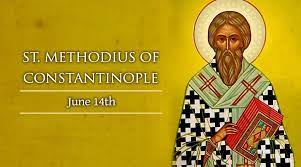Methodios was born to wealthy parents in 788, Syracuse. He was sent as a young man to Constantinople to continue his education and hopefully attain an appointment at court. But instead, he entered a monastery in Bithynia, eventually becoming abbot.
Under Emperor Leo V the Armenian (813–820) the Iconoclast persecution broke out for the second time. In 815 Methodios went to Rome, perhaps as an envoy of the deposed Patriarch Nikephorοs. Upon his return in 821 he was arrested and exiled as an iconodule by the Iconoclast regime of Emperor Michael II. He was released in 829 and assumed a position of importance at the court of the even more fervently iconoclast Emperor Theophilos.
Soon after the death of the emperor, in 843, the influential minister Theoktistos convinced the Empress Mother Theodora, as regent for her two-year-old son Michael III, to permit the restoration of icons by arranging that her dead husband would not be condemned. He then became the Patriarch. A week after his appointment, accompanied by Theodora, Michael, and Theoktistos, Methodios made a triumphal procession from the church of Blachernae to Hagia Sophia on March 11, 843, restoring the icons to the church.
Throughout his short patriarchate, Methodios tried to pursue a moderate line of accommodation with members of the clergy who were formerly Iconoclasts. This policy was opposed by extremists, primarily the monks of the Stoudios monastery, who demanded that the former Iconoclasts be punished severely as heretics. To rein in the extremists, Methodios was forced to excommunicate and arrest some of the more persevering monks.
Methodios was indeed well-educated; engaged in both copying and writing manuscripts. His individual works included polemica, hagiographical and liturgical works, sermons and poetry.



